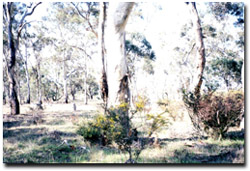Site 11 Lexton North Water Reserve
The site is at possible risk from groundwater discharge.
Description
The site is surrounded by sedimentary hills and is at an elevation of 300 metres. The remnant vegetation is significant as much of the Ben More Range located close by has been cleared of the original Box-Ironbark vegetation. Previous activities at the reserve have been grazing (a grazing licence was removed approximately 15 years ago) and timber harvesting activities. Saline discharge is occurring along a drainage line within the reserve and visible salt scalds are present. Therefore the vegetation is highly threatened from dryland salinity.
Vegetation Description and Composition The EVC represented at this site is Box Ironbark (Western Goldfields) and the open woodland community is dominated by Eucalyptus leucoxylon (Yellow Gum) and Eucalyptus goniocalyx (Long-leaf Box) with a minimal shrub layer. The herbaceous layer consists of Danthonia spp. (Wallaby Grass), Tricoryne elatior (Yellow Rush-lily) and Lomandra spp. (Mat Rush). The most significant introduced species are Briza maxima (Quaking Grass) and Briza minor (Lesser Quaking Grass). Many introduced grasses have reduced in cover abundance due to dry seasonal conditions and probable grazing pressures from hares, rabbits and wallabies. Two salt indicator species are present being, Lolium spp. (Rye Grass) and Polypogon monspeliensis (Annual Beard Grass). Their further spread remains of concern due to salt discharge occurring nearby, but still may be just a response to the seasonal variations. Further information is needed through soil salinity testing. |  Lexton North Reserve contains a good shrub layer that is excellent habitat for many small bird species |
Tree Health
Eight trees are monitored for tree canopy health using a 20-point system assessing canopy size and density, number of dead branches and extent of epicormic growth. Leaf damage by insects is also assessed. Most trees have not changed in health since monitoring commenced in 1997, however scores are quite low for some trees due to reduced canopy density and high level of epicormic growth. Prolonged dry conditions and isolation from other stands of remnant vegetation are placing large amounts of stress upon these trees.
Groundwater and Salinity
Two bores are located close to the reserve and the water table was within 4m of the surface in 2002. These levels are concerning given that the last few seasons have recorded below average rainfall and yet groundwater levels are still quite close to the surface. Salinity readings from both bores were >10 000 EC (i.e. very saline water that would create severe salinity problems if drawn to the surface).
Birds
Bird species present at the time of the vegetation and tree health surveys were :-
Corella, Galah, Kookaburra, Magpie, Red-rumped Parrot, Striated Pardalote, Welcome Swallow, Willie Wagtail, Noisy Miner, Superb Fairy Wren and Eastern Rosella.
Site Threats
- kangaroo grazing.
- Vehicle tracks and compaction of site.
- Possible discharge site.
- Continued weed invasion from adjacent farmland.
- Possible risk of fire.


